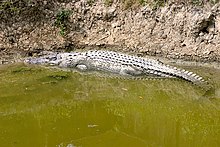Sundarbans National Park
| Sundarbans National Park | ||
|---|---|---|
| Tiger in Sundarbans National Park | ||
|
|
||
| Location: | West Bengal , India | |
| Next city: | Calcutta | |
| Surface: | 1330 km² | |
| Founding: | 1984 | |
The Sundarbans National Park ( Bengali সুন্দরবন জাতীয় উদ্যান , Sundaraban Jātīẏa Udyān ) is a national park and part of a tiger sanctuary and a biosphere reserve in the Indian state of West Bengal . The park is located in the Sundarbans in the Ganges Delta and borders the Sundarban Reserve Forest in Bangladesh . The river delta is densely covered with mangrove forests. It is one of the largest living areas of the King Tiger , home to many different species of birds, reptiles such as the saltwater crocodile and invertebrates . The current Sundarban National Park was designated the core area of the Sundarban Tiger Reserve in 1973 and a nature reserve in 1977. On May 4, 1984 it became a national park.
In 1987, UNESCO recognized the national park as a world natural heritage site . It fulfilled two of four criteria for inclusion in the World Natural Heritage List: an excellent example of ecological and biological processes (ix) and significant natural habitats for species protection (x). According to UNESCO, the Sundarbans mangroves represent one of the most biologically productive ecosystems in the world.
location

Sundarbans National Park is located between 22 ° 25 'and 21 ° 55' north latitude and between 88 ° 42 'and 89 ° 04' east longitude. The average height in the park is 7.5 meters above sea level. The park consists of 54 small islands and is flowed through by various foothills of the Ganges .
climate
The temperatures are on average between 20 ° C (minimum) and 48 ° C (maximum). The rainfall is heavy and the humidity is 80% due to the proximity to the Bay of Bengal . The monsoons last from mid-June to mid-September. The prevailing wind comes from the north and northeast from October to mid-March, with southwest winds prevailing in the remaining months. Storms, which can sometimes develop into cyclones , occur in the months of May and October.
Ecosystem
Seven rivers and countless watercourses form a network of canals in the estuary delta. All rivers flow south to the sea. The area's ecosystem is dependent on the tidal effect of two floods and two ebbs. Within 24 hours there is a tide range of three to five meters, up to eight meters in spring. The entire Sundarbans are flooded to different degrees. The tides deposit sediments in the channels and lift the river bed, forming new islands and streams, resulting in an ever-changing geomorphology . In the Bay of Bengal there is a channel between 21 ° 00 'and 21 ° 22' which marks the beginning of an underwater canyon called the Swatch of No Ground . In this depression the water depth drops abruptly from 20 to 500 m. Large amounts of sediment from the Ganges-Brahmaputra river system are transported along this canyon into the Bay of Bengal, at the same time it could limit the seaward displacement of the submarine part of the Ganges delta. Possibly this promotes the formation of islands.
Wadden Sea
The Wadden Sea of the Sundarbans stretches across the Ganges Estuary and the islands of the delta, where slowly flowing water meets the tidal currents. At low tide the mudflats are visible, at high tide it is washed over by the water, so that it can change morphologically in a tidal cycle. The inner parts of the mudflats are the suitable environment for mangroves .
Outside the park there are parts of the mudflat that are visited by tourists at low tide. With a little luck, you can spot sea anemones , horseshoe crabs and small octopuses there .
Flora and fauna
flora
The name "Sundarban" is similar to the Sundari tree ( Heritiera fomes ). It is the most exquisite species of tree in the area, a special kind of mangrove trees . It has special aerial roots that protrude from the ground and ensure better uptake of nutrients. In the rainy season, when the whole forest is soaked in water, the tips protrude from the ground into the air, which enables cell respiration.
fauna
Mammals
The Sundarbans Forests are home to more than 400 tigers. The King or Bengal tiger has a unique form of swimming in salt water and is notorious for attacking people. Tigers can be seen sunbathing on river banks in the park from November to February.
In addition to the tigers are fishing cats , leopard cats , macaques , wild boar , Indian mongooses , foxes , jungle cats , bats , pangolins and Axishirsche other mammalian species that are abundant in the park.
Birds
The following bird species in the area before: open billed stork , black-capped kingfisher , black-headed ibis , common moorhen , coots , pheasants Jacana , Black Kite , Brahminy Kite , Marsh Harrier , Marsh Frankolin , junglefowl , spotted dove , Myna , jungle crow , Cotton Pygmy Goose , Caspian tern , gray heron , common snipe , wood sandpiper , green pigeon , Ring-necked parakeet , cormorants , gray-headed eagles , white-bellied sea eagles , gulls , kingfisher , peregrine falcon , woodpeckers , whimbrel , godwit , pygmy sandpiper , great knot , curlew , plover , pintail , bog duck and pygmy goose .
Aquatic animals
Saw rays , medusa fish , electric rays , silver carp , starfish , carp , horseshoe crabs , shrimps , ganges dolphins , common toads and rowing frogs can be found in the park .
Reptiles
Sundarbans National Park is also home to a wide variety of reptiles, including estuarine crocodiles , monitor lizards, and turtles . Tiger python , king cobra , chain viper and common krait are among the snakes .
Endangered species
The bengal tiger , saltwater crocodile , Batagur turtle , olive hybrid turtle , ganges dolphin , hawksbill turtle and mangrove horseshoe are among the endangered species of the Sundarbans.
Administration and protection projects
The King Tiger is at the top of the ecological pyramid in this national park . He has been taking care of tiger protection since it was founded. The core zone is free from any human interference such as the gathering of wood, honey, fish and other forest products. In the buffer zone, fishing, collecting honey and cutting wood is conditionally permitted. Armed forest rangers patrolling motor boats and launches protect the park from poachers and wood thieves. Forest offices and warehouses are located at important points in the park.
The habitat of the wild animals is preserved through various protective measures. Ten forest protection committees and 14 eco-development committees have been set up on the edge of the Sundarbans Tiger Reserve to help in this regard. Seminars, workshops and attention camps are held near the park to educate the population about environmental protection. Mangroves and other plants are planted on the outskirts in order to supply around 1000 villages with firewood and to protect the buffer zone. Soil protection serves to maintain the ecological balance. Several freshwater ponds have been created where the wildlife can find potable water.
Repelling tiger attacks is another important activity. The number of deaths has been reduced from 40 to 10 per year. This success is the result of strict control of the movements of people in the tiger reserve, the creation of new incomes and the promotion of mindfulness among the population. The wandering of tigers into nearby villages is prevented by means such as nylon fences and the sunshine of the villages. Electric human dummies are also supposed to keep the tigers away from people.
In Sajnekhali, there is a lodge for ecotourists and a mangrove interpretation center , which draws the local population and tourists out of the importance of the mangrove ecosystem.
The protection of the park faces some challenges: the topography consists of obstructive terrain with innumerable watercourses, a long state border with Bangladesh, poaching and logging is made easier by fishing trawlers and barges, which affects the mangrove forests. A lack of staff, infrastructure and money make the situation more difficult.
Web links
- Tourist website with information about the national park
- Entry on the UNESCO World Heritage Center website ( English and French ).
- UNESCO Periodic Report (2003)
Individual evidence
- ↑ Description of UNESCO , accessed on November 30, 2016.
- ^ A b Ghosh RK and Mandal AK (1989). Sunderban - a socio bio-ecological study . 1st edition, Bookland Pvt. Ltd. Calcutta.
- ↑ a b Banerjee A. (1998). Environment, population and human settlements of Sunderban Delta . 1st edition, Concept Publishing Company, New Delhi.
- ^ Bhattacharya AK (1989). "Coastal geomorphology, processes and hazards: a note on management measures". Proc. Coast zone management of West Bengal , Sea Explorers' Institute, Calcutta. pp. D49-61.
- ^ J. Fergusson: Delta of the Ganges. In: Quarterly Journal of the Geological Society of India . Vol. XIII. Part-1. 1863 ( doi: 10.1144 / GSL.JGS.1863.019.01-02.35 ).
- ^ SA Kuehl, MA Allison, SL Goodbred, H. Kudrass: The Ganges-Brahmaputra Delta . In: Liviu Giosan, Janok P. Bhattacharya (Ed.): River Deltas-Concepts, Models, and Examples . January 2005, doi : 10.2110 / pec.05.83.0413 .
- ↑ Periodical Report of UNESCO (2003), pp. 77/78.
- ↑ Periodical Report of UNESCO (2003), pp. 79–81.
- ↑ Periodical Report of UNESCO (2003), pp. 82–86.
- ↑ Periodical Report of UNESCO (2003), p. 76.
- ↑ Periodical Report of UNESCO (2003), pp. 9 and 88.
- ↑ Periodical Report of UNESCO (2003), p. 37.
- ↑ Periodical Report of UNESCO (2003), pp. 26/27.
- ↑ Periodical Report of UNESCO (2003), p. 30.
- ↑ Periodical Report of UNESCO (2003), p. 24.
- ↑ Periodical Report of UNESCO (2003), p. 20.





